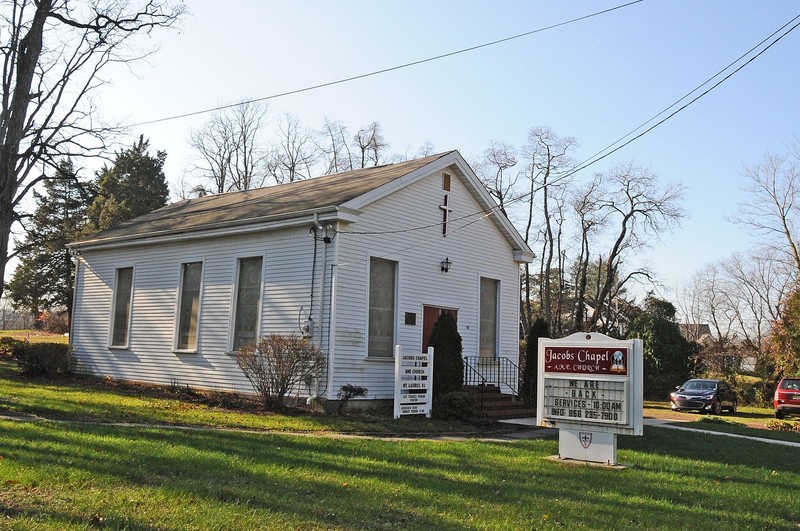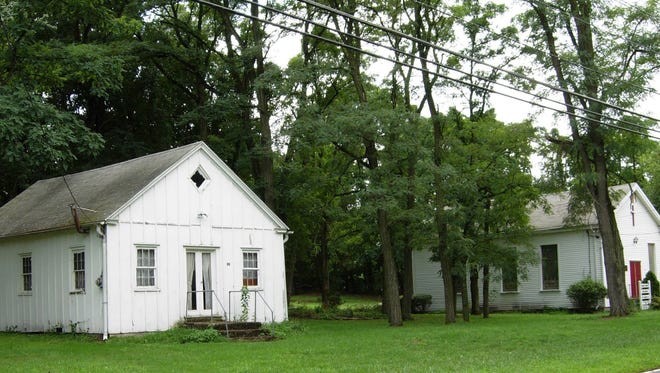Jacob's Chapel A.M.E. Church
Introduction
Text-to-speech Audio
Images
Jacob's Chapel A.M.E.

The 1840 Meetinghouse and Jacob's Chapel

Backstory and Context
Text-to-speech Audio
The Jacob's Chapel A.M.E Church property, which includes the Colemantown Meeting House, chapel, and cemetery, survives as one of the last remaining resources that mark the emergence and growth of Colemantown, an antebellum African American settlement established in 1828. The church also functioned as an Underground Railroad escape stop for Southern slaves. The Meeting House, constructed in 1840 and moved to its current location in 1965, served dually as Colemantown's first worship sanctuary and schoolhouse; it is one of New Jersey's oldest standing all-Black schoolhouses. In fact, before roughly 1840, few Black churches worshiped in buildings they built. Instead, they typically met in re-purposed structures. The Colemantown Meeting House survives as the only known survivor of the first Black-congregation-built chapels. After the Civil War, the growing congregation, then led by Jacob Mitchell, an A.M.E minister known for his success in building Black churches, led the effort to build the present Jacob's Chapel in 1866-67. In addition to its significance during the nineteenth century, Jacob's Chapel served as a principal actor during the 1970s and 1980s New Jersey litigations that challenged exclusionary residential zoning laws; landmark cases that influenced laws nationwide.
Though sources are scarce, documents show that slave ownership existed within Evesham Township during the first decade of the 1700s and likely earlier. Many of the slaveholders were members of the Society of Friends in America (Quakers), who wrestled with the issue. Though the Society of Friends in England discussed its morality as early as the late 1600s, it wasn't until the 1750s that Philadelphia-area Quaker meetings discussed a plan to manumit slaves and educate Black children. By the 1780s, an abundance of newly freed slaves, along with runaways, formed the foundation of Evesham's Black community, totaling eighty-one by 1797, according to a census conducted by the Burlington County Abolition Society.
Black settlements also became possible due to the passage of the New Jersey 1804 Gradual Abolition Act, which led to increasing free Blacks living in New Jersey by the 1820s. In 1822, a group of Quakers formed the Association for the Care of Coloured Orphans (ACCO), which established the shelter to offer a full array of services to Black Americans including living quarters, meals, personal hygiene and medical care, education, and access to apprenticeship programs for teenagers. A few years later, Charles Coleman purchased one and one-half acres from local Quaker farmer Edmund Darnell in 1828, which evolved into Colemantown.
The roots of Jacob's Chapel African Methodist Episcopal Church (hereafter, A.M.E.) dates back to the 1760s with the story of a slave named Richard Allen. At the age of twenty, he converted to Christianity and began holding prayer meetings in his master's home, which convinced his master that slavery was morally unjust; Allen gained his freedom. Allen eventually became a minister and planted his first Black church in 1794, located in Philadelphia. Allen, along with other Black ministers, faced difficulties in securing locations to worship. Thus, in 1816, Allen founded the A.M.E denomination, joined by sixteen Black churches in Baltimore and Philadelphia. Records indicated that as early as 1824, Evesham had its first A.M.E congregation with forty-two members. The Evesham A.M.E moved to Colemantown in roughly 1840 and subsequently built (or procured) a meetinghouse.
Evesham A.M.E existed as a stop along the Underground Railroad, mainly organized by William Still, son of escaped slaves Charity and Levin Still (before the establishment of the Underground Railroad). Most of the Still family was buried at the church's cemetery. By the time of the Civil War, the congregation grew substantially, requiring its members to erect a new chapel. Led by its new pastor, Jacob Mitchell, who arrived in 1866, construction finished on the chapel in 1867. After its completion, the Evesham/Mount Laurel A.M.E. Church became known as "Jacob's Chapel."
More recently, the Jacob's Chapel A.M.E. Church is also directly connected to the landmark Mount Laurel exclusionary zoning lawsuits in 1975 and 1983, decided by the New Jersey Supreme Court in which Jacob's Chapel members were principal plaintiffs. The rulings significantly influenced fair-housing policies nationwide and limited the use of exclusionary zoning as a means of preventing the construction of affordable housing in wealthy communities. Numerous law review articles since the 1980s reference the cases, and the editors of Planning and Environmental Law included Mount Laurel as one of the United States' most significant planning and environmental law cases. Moreover, a 2013 New York Times editorial noted, "The New Jersey Supreme Court's 1983 ruling in the Mount Laurel [II] fair-housing case is rightly regarded as one of the most important civil rights decisions of modern times."
The A.M.E, Jacob's Chapel, and Colemantown emerged because African Americans needed to forge their own, supportive communities. To see the chapel today is to look back through the long journey African Americans have taken from a time of slavery through real-estate discrimination issues of the late twentieth century, sometimes literally. Indeed, the current (as of 2021) Pastor of Jacob's Chapel has ancestors connected to the Underground Railroad, of which Jabob's Chapel was a stop before the Civil War.
Sources
"Colemantown Meeting House / Jacob's Chapel." Preservation New Jersey. preservationnj.org. 2017. https://www.preservationnj.org/listings/colemantown-meeting-house-jacobs-chapel/.
Person, Terrell W. If These Stones Could Talk. Christian Kids Network. Inc. January 28, 2021. https://www.facebook.com/jacobschapel/posts/4043640805655535.
Schopp, Paul W. and Douglas McVarish. "Nomination Form: Jacob's Chapel A.M.E. Church." National Register of Historic Places. nps.gov. 2015. https://npgallery.nps.gov/GetAsset/7a0c65b3-f363-4968-9a1b-34cf3c9eb022.
Tyler, Mark Kelly. "Underground Railroad History made in South Jersey AME Church." Tyler's AME History Notes (blog) with an article taken from DeCastro, Lavinia. USA Today's Courier-Post (Mt. Laurel), October 22, 2008. http://markkellytyler.blogspot.com/2008/10/underground-railroad-history-made-in.html.
By JERRYE & ROY KLOTZ, M.D. - Own work, CC BY-SA 4.0, https://commons.wikimedia.org/w/index.php?curid=45447762
https://www.courierpostonline.com/story/news/local/2017/06/15/colemantown-mount-laurel-designated-national-historic-site/396842001/
